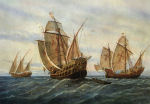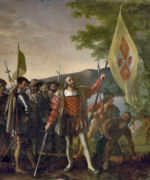| ser·en·dip·i·ty [ser-uhn–dip-i-tee] — noun the faculty of making fortunate discoveries by accident |
Psychiatry, The Pharmaceutical Industry, and The Road to Better Therapeutics
by H. Christian Fibiger
Schizophrenia Bulletin. 2012 38(4):649–650.
… The discovery of all three major classes of psychiatric drugs, antidepressants, antipsychotics, and anxiolytics, came about on the basis of serendipitous clinical observation. At the time of their discoveries, the mechanisms by which these molecules produce their effects were unknown, and it was only later that antipsychotics were shown to be D2 receptor antagonists, antidepressants monoamine reuptake inhibitors, and anxiolytics GABA receptor modulators. It is interesting and perhaps instructive to consider whether any of these classes of drugs could have been discovered by current drug discovery strategies. For example, what genetic or preclinical data exist that point to the D2 dopamine receptor as a likely target for antipsychotic activity? Presently there are no genetic data that suggest that this receptor is expressed or functions abnormally in psychotic disorders. And without the benefit of the prior clinical validation, it is difficult to see how preclinical data alone would point to the D2 receptor as an interesting potential target for the treatment of psychotic disorders. The same can be said for monoamine transporters with respect to depression where, like psychosis, there are no animal models based on disease pathophysiology and no compelling preclinical data pointing to these as potential targets for antidepressant drugs. This raises a troubling question: if in retrospect the three major classes of currently prescribed psychiatric drugs would likely never have been discovered using current drug discovery strategies, why should we believe that such strategies are likely to bear fruit now or in the future?…
What the field lacks is sufficient basic knowledge about normal brain function and how its disturbance underlies the pathophysiology of psychiatric disease. Because of this, as the record now clearly shows, it remains too early to attempt rational drug design for psychiatric diseases as currently conceived. The most obvious solution here is expanded investment in neuroscience. By necessity, this will be driven primarily by the efforts of clinical and basic scientists in academic settings because industry no longer has the appetite or the resources to engage in such activities. It is worth emphasizing that industry is in the business of making drugs, knowledge sometimes being a fortuitous byproduct. Academia is in the business of generating knowledge, and knowledge is what is needed at present…
Alexander Fleming returned to his research laboratory at St. Mary’s Hospital in London after World War I. His battlefront experience had shown him how serious a killer bacteria could be, much worse even than enemy artillery. He wanted to find a chemical that could stop bacterial infection. He discovered lysozyme, an enzyme occurring in many body fluids, such as tears. It had a natural antibacterial effect, but not against the strongest infectious agents. He kept looking. Fleming had so much going on in his lab that it was often in a jumble. This disorder proved very fortunate. In 1928, he was straightening up a pile of Petri dishes where he had been growing bacteria, but which had been piled in the sink. He opened each one and examined it before tossing it into the cleaning solution. One made him stop and say, "That’s funny." Some mold was growing on one of the dishes… not too unusual, but all around the mold, the staph bacteria had been killed… very unusual. He took a sample of the mold. He found that it was from the penicillium family, later specified as Penicillium notatum. Fleming presented his findings in 1929, but they raised little interest. He published a report on penicillin and its potential uses in the British Journal of Experimental Pathology. Fleming worked with the mold for some time, but refining and growing it was a difficult process better suited to a chemist. The work was taken over by a team of chemists and mold specialists, but was cut short when several of them died or relocated.
In 1935, Australian Howard Florey was appointed professor of pathology at Oxford University where he headed up a laboratory. This was a daunting task in an economically depressed time, and seeking funding for the researchers and work he hoped to do took much of his time. One researcher he hired soon after his arrival was Ernst Chain. Chain was paid to do cancer research, and work that spilled over into Florey’s own interest and work on lysozyme. Chain became quite enthusiastic about the search for antibacterial chemicals. In looking back at old articles written about lysozyme, including those by Fleming in the 1920s, he happened across Fleming’s paper on penicillin. "I had come across this paper early in 1938 and on reading it I immediately became interested," he wrote.he Oxford team, as Florey’s researchers have become known, began experimenting with the penicillin mold. They took it one step further than Fleming did: they did not just try it topically or in a petri dish, but injected it in live mice. With controlled experimentation, they found it cured mice with bacterial infections. They went on to try it on a few human subjects and saw amazing results.
By now it was 1941, and England was at war. As Fleming first foresaw, the wartime need for an antibacterial was great, but resources were tight and penicillin still very experimental. Florey had connections at the Rockefeller Foundation in the United States, however, and it funded further research. The biggest problem was producing enough penicillin. This was hard and expensive to accomplish. Florey and another researcher traveled to the U.S. to talk to chemical manufacturers and ended up in Peoria, Illinois. An agricultural research center there had developed excellent techniques of fermentation, a process needed for penicillin growth. The agriculture of Illinois proved useful, too. The nutrient base for the penicillin grown there was corn (maize), which was not commonly grown in Britain. The penicillin loved it, and yielded almost 500 times as much as it had before. More vigorous and productive strains of the mold were sought, and one of the best came from a rotting canteloupe from a Peoria market! By this point, the United States had entered World War II as well. Penicillin’s benefits was now known, and the government pushed industry into producing penicillin, recruiting more than 21 chemical companies into production. From January to May 1943, only 400 million units of penicillin had been made; by the time the war ended, U.S. companies were making 650 billion units a month.
 The spherical shape of the earth was not a secret waiting for Christopher Columbus’ birth to reveal itself. Aristotle [384-322 BC] knew it based on the shadow the earth cast on the moon and the differing night skies at distant places. Eratosthenes [276-194 BC] first calculated a circumference of the earth based on the differing noon shadow angles at the antipodes of the Nile, initiating centuries of further calculations by others using different methods. Columbus was hardly the first sailor that noticed that when ships sailed into the distance, they appeared to sink rather than just get smaller. He was a guy who wanted to find a route to the lucrative Indian Spice Trade by sea. So he came up with his own calculations of the circumference of the
The spherical shape of the earth was not a secret waiting for Christopher Columbus’ birth to reveal itself. Aristotle [384-322 BC] knew it based on the shadow the earth cast on the moon and the differing night skies at distant places. Eratosthenes [276-194 BC] first calculated a circumference of the earth based on the differing noon shadow angles at the antipodes of the Nile, initiating centuries of further calculations by others using different methods. Columbus was hardly the first sailor that noticed that when ships sailed into the distance, they appeared to sink rather than just get smaller. He was a guy who wanted to find a route to the lucrative Indian Spice Trade by sea. So he came up with his own calculations of the circumference of the  earth and the distance to India. He thought he could make it. He took his enticing business plan to the Spanish government. A government panel of experts thought his calculations were wrong, but Queen Isabella over-ruled them; Columbus got his funding; and so off he went. Columbus’ calculations turned out to be wrong – very wrong. Had it not been for the serendipitous presence of an intervening continent [something they hadn’t imagined], he would never have survived the real distance to India, nor would he likely have had the supplies to make it back to Spain. So that would’ve been that – Christopher Columbus, a dead crackpot who was bad with numbers, instead of Christopher Columbus, discoverer of the New World.
earth and the distance to India. He thought he could make it. He took his enticing business plan to the Spanish government. A government panel of experts thought his calculations were wrong, but Queen Isabella over-ruled them; Columbus got his funding; and so off he went. Columbus’ calculations turned out to be wrong – very wrong. Had it not been for the serendipitous presence of an intervening continent [something they hadn’t imagined], he would never have survived the real distance to India, nor would he likely have had the supplies to make it back to Spain. So that would’ve been that – Christopher Columbus, a dead crackpot who was bad with numbers, instead of Christopher Columbus, discoverer of the New World.
Sorry, the comment form is closed at this time.